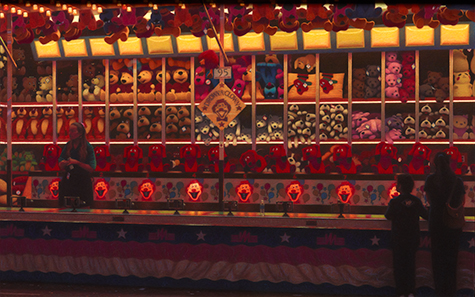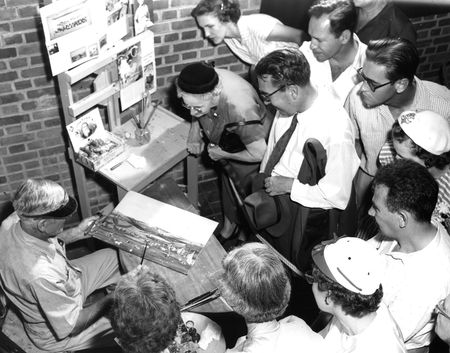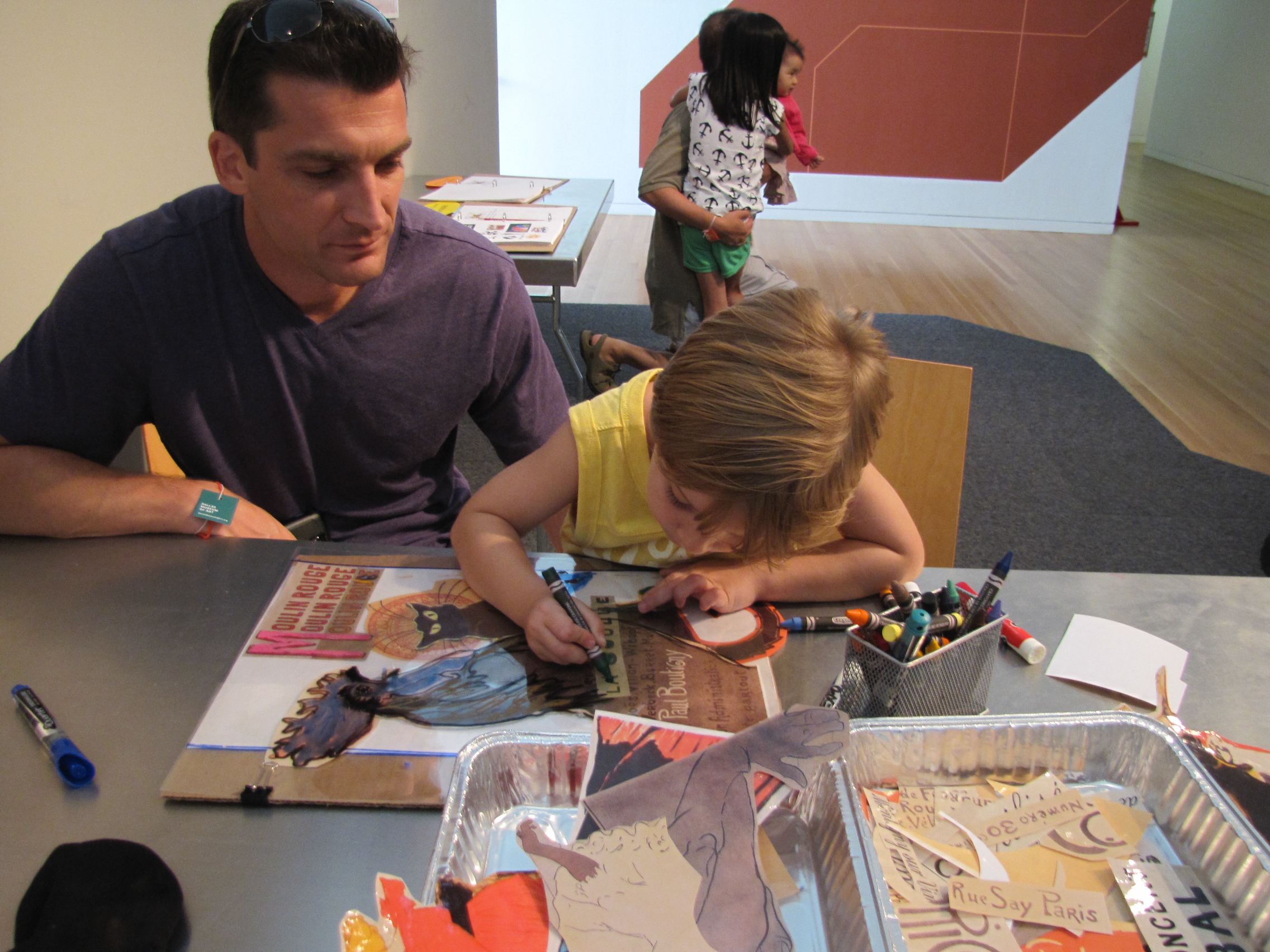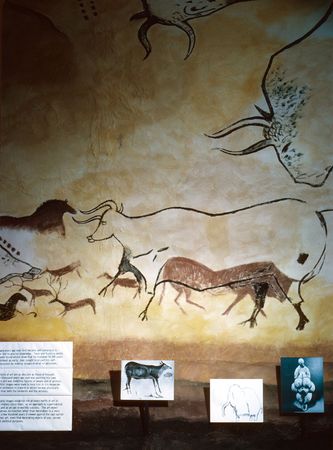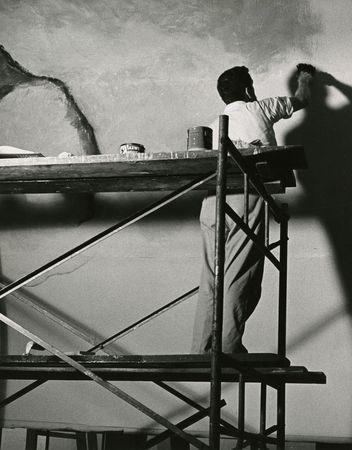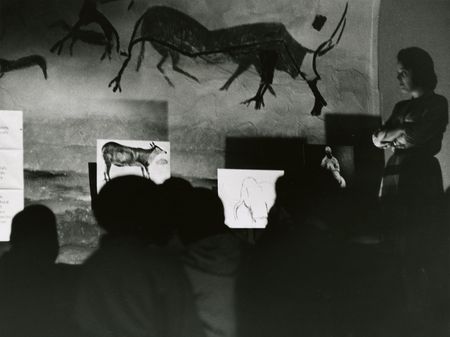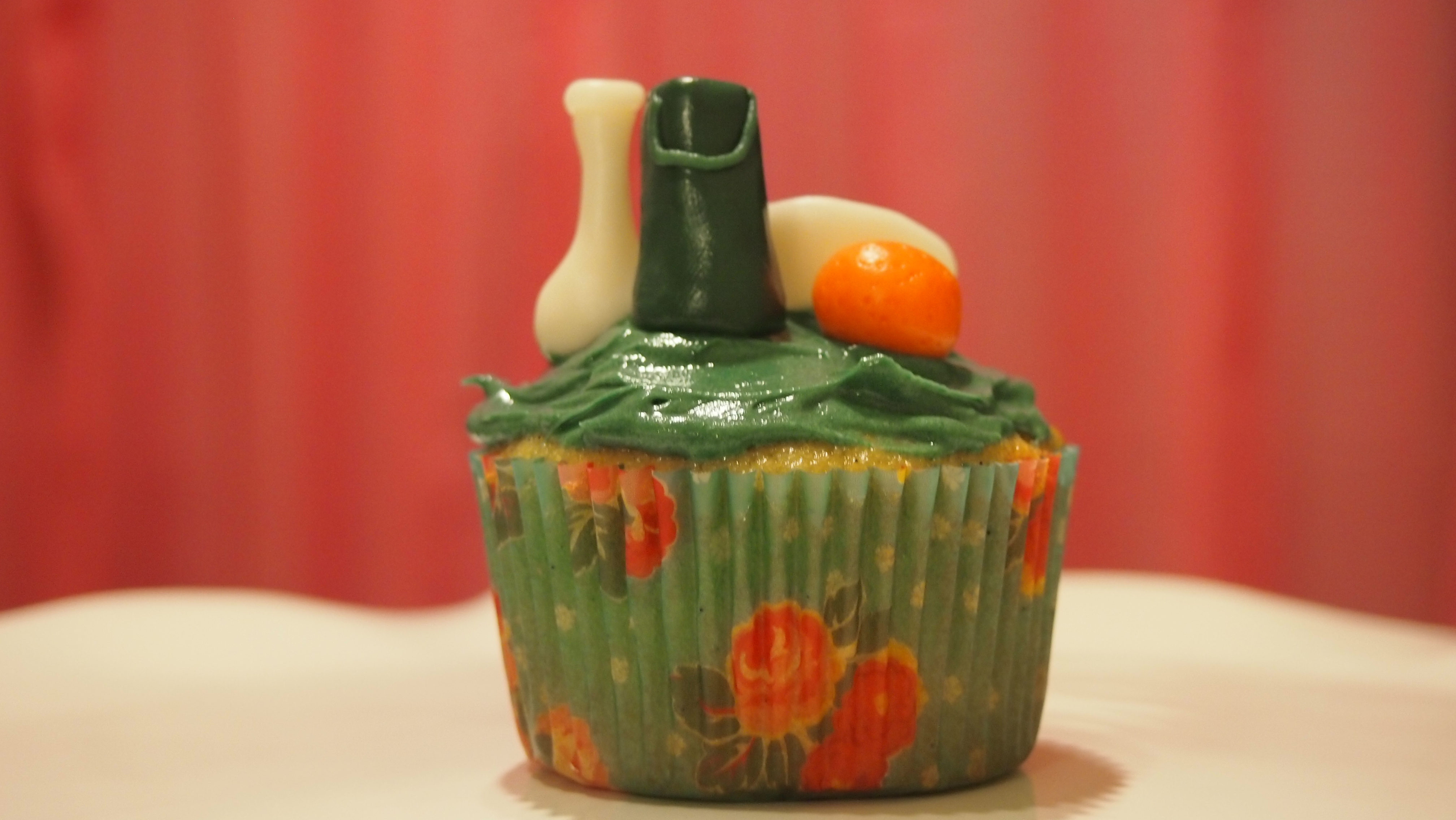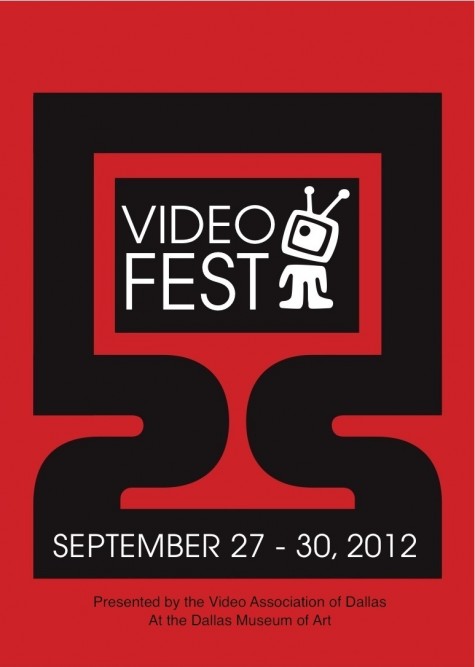Don’t Miss it; don’t even be late! Opening today, the State Fair of Texas inspired us to unearth a few gems from the collection.
Archive for September, 2012
“Our State Fair is a Great State Fair”
Published September 28, 2012 Archive , Collections , Exhibitions ClosedTags: Brian Cobble, Drown a Clown, H. O. Kelly, State Fair of Texas
Artist H. O. Kelly demonstrates painting in the Museum Court during the 1960 State Fair. An H. O. Kelly Retrospective was one of the Museum’s exhibitions for the 1960 Fair.
Friday Photos: Welcome, Elijah!
Published September 28, 2012 Friday Photos 3 CommentsTags: education department, Melissa Nelson, People
I feel most privileged to introduce you to Mr. Elijah Nelson Gonzales, the youngest member of the DMA family! Melissa and her husband welcomed healthy little Eli into the world on Monday, September 10. We think he’s about the cutest thing ever – don’t you agree?
Congratulations Melissa! We’re missing you while you’re away from the office (and the blog), and we look forward to seeing you soon. Bring Eli by the DMA any time you want – the world of art is waiting for him…
Nicole Stutzman
Chair of Learning Initiatives and Dallas Museum of Art League Director of Education
The Man with the Top Hat
Published September 27, 2012 Creativity 1 CommentTags: Art, Center for Creative Connections, creativity, Dallas Museum of Art, exhibition, Posters of Paris
In preparation for the upcoming exhibition Posters of Paris: Toulouse-Lautrec and His Contemporaries, the Center for Creative Connections staff has been prototyping a new interactive art-making activity. Inspired by poster-making at the Denver Art Museum, we are including a hands-on poster-making space in the exhibition. Our current prototype activity has a limited array of characters which our visitors can choose and combine to create their own poster; but as you can see, creativity still flourishes. Though each of these three posters below uses the man with the top hat in a similar placement in the composition, the context in which he is placed is quite different.
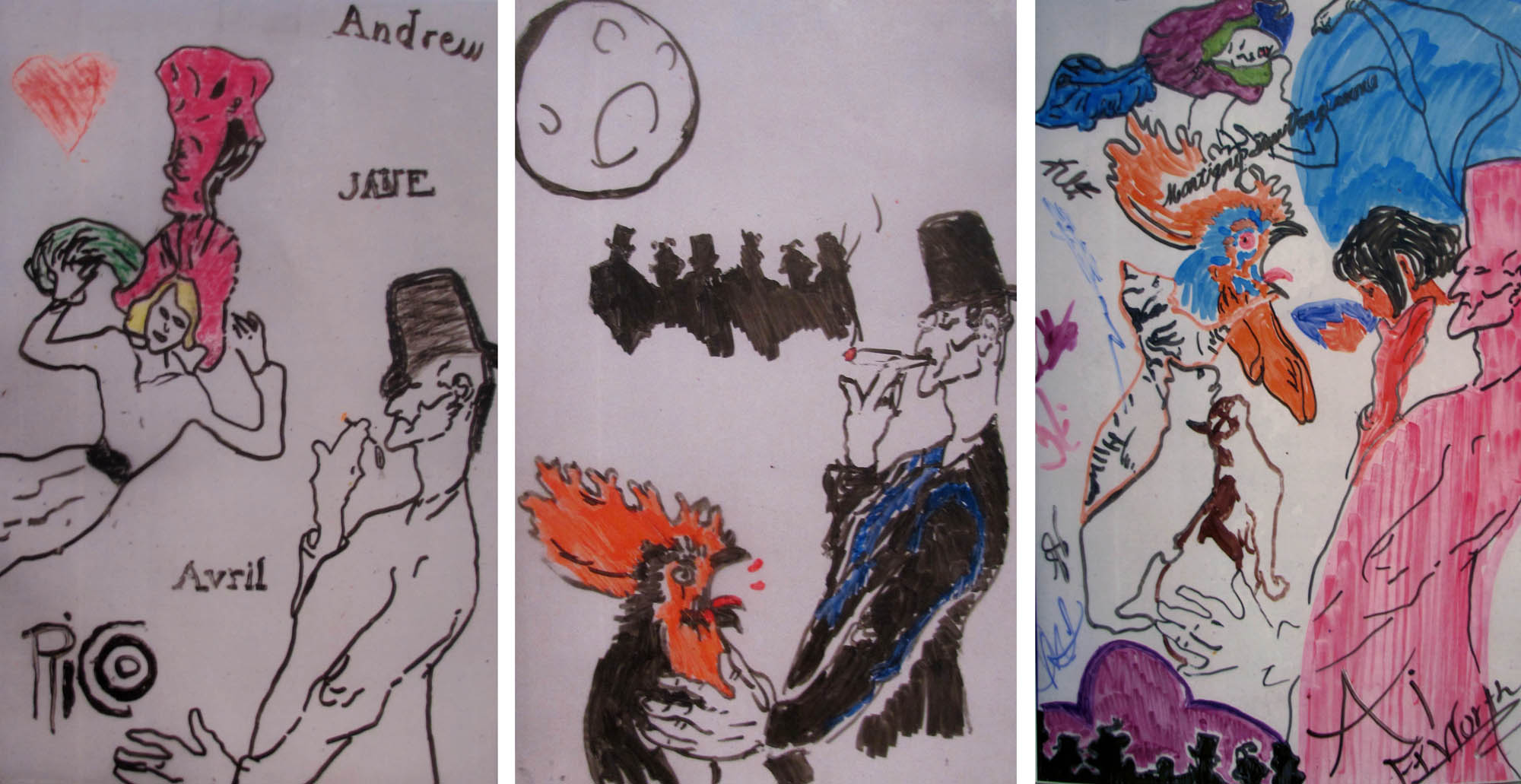
On the left is an 8-year-old boy’s romantic combination of the man with the top hat (with a slender cigarette) and Jane Avril. In the middle, a young man has replaced that slender cigarette with a hefty cigar. All of the romance is gone with the shadowy figures in the background looking on as the man with the top hat strangles a poor rooster. Pictured on the right is a collaborative piece created by a group of women from the Art Institute of Fort Worth. Each woman took a turn adding to the composition in what ended up as a playful hodge-podge.
Swing by the Dallas Museum of Art from October 14 – January 20 to see Posters of Paris and create your own poster! What will you do with the man with the top hat?
Jessica Nelson
C3 Gallery Coordinator
Bon Voyage to The Icebergs
Published September 26, 2012 American Art , Behind-the-Scenes , Curatorial 2 CommentsTags: Better Angels of Our Nature: The Arts during the Civil War and Reconstruction, D.C., Dallas Museum of Art, Frederic Edwin Church, Metropolitan Museum of Art, Smithsonian American Art Museum in Washington
Considered by some to be the DMA’s Mona Lisa, Frederic Edwin Church’s The Icebergs has been a destination icon for museum visitors ever since it was placed on display in 1979. Measuring slightly over 7 feet high and 11 feet wide in its frame, and weighing a cumbersome 425 pounds, it is the anchor of the American galleries in both a figurative and literal sense. Consequently, its presence is as keenly felt as its absence. Yet, there are times when a museum must make a sacrifice—albeit reluctantly–in the support of new art historical scholarship.

Frederic Edwin Church, “The Icebergs,” 1861, oil on canvas, Dallas Museum of Art, gift of Norma and Lamar Hunt, 1979.28
The Icebergs is to play a pivotal role in the presentation of the upcoming exhibition The Civil War and American Art, which will open at the Smithsonian American Art Museum and travel to the Metropolitan Museum of Art in New York. Longtime members of the DMA will be pleased to know that this important exhibition has been organized by the DMA’s former curator of American Art Dr. Eleanor Jones Harvey, who has been with the Smithsonian American Art Museum since 2003. The exhibition will feature key works by America’s greatest artists of the era. These works channeled the conflicting emotions of a nation coming to grips with a reality that altered the very fabric of its identity and transformed its once unassailable optimism into dread for the unknown outcomes that lay ahead.
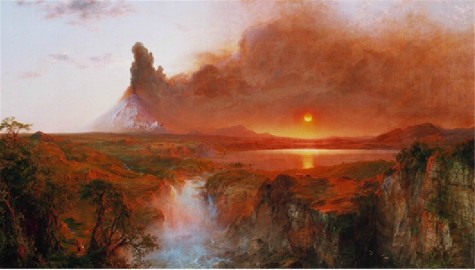
Frederic Edwin Church, “Cotopaxi,” 1862, oil on canvas, Detroit Institute of Arts, Founders Society Purchase, Robert H. Tannahill Foundation Fund, Gibbs-Williams Fund, Dexter M. Ferry Jr. Fund, Merrill Fund, Beatrice W. Rogers Fund, and Richard A. Manoogian Fund, Photo courtesy Detroit Institute of Arts
Key to charting the path from America’s loss of faith to its eventual hope of redemption will be four monumental landscapes by Frederic Church: The Icebergs, Cotopaxi, Aurora Borealis, and Rainy Season in the Tropics. The first two works have often been paired in a binary context of arctic and tropics, but, in this presentation, their multiple layers of meaning are to be revealed. In the case of The Icebergs, Church changed its title to The North for its debut just twelve days after the beginning of the war in 1861. He also donated all the ticket proceeds to the Union Red Cross. In his painting of the following year, Cotopaxi, Church depicted paradise rent asunder by the volcanic and explosive forces of nature as a symbolic reflection of the cleaving of a nation. A month before the end of the war, Church exhibited Aurora Borealis, wherein the darkness of the endless arctic winter echoed the weariness that dominated the American psyche. In Rainy Season in the Tropics, presented in 1866 after the close of the war, Church delivered the viewer—and a nation—from its trials and tribulations into a paradise redeemed by a nourishing rain and the promise of a double rainbow.
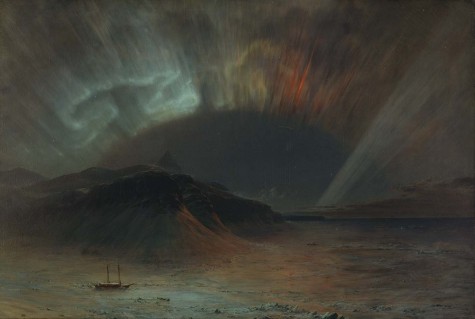
Frederic Edwin Church, “Aurora Borealis,” 1865, oil on canvas, Smithsonian American Art Museum, Gift of Eleanor Blodgett, Photo courtesy Smithsonian American Art Museum

Frederic Edwin Church, “Rainy Season in the Tropics,” 1866, oil on canvas, Fine Arts Museums of San Francisco, Museum purchase, Mildred Anna Williams Collection
For those wanting to bid a fond farewell to The Icebergs before its departure, please be sure to do so before mid-October, when it will be removed from view. If you would like to see the DMA’s masterpiece in the context of the exhibition, it will be at the Smithsonian American Art Museum in Washington, D.C., November 16, 2012–April 27, 2013, and then in New York at the Metropolitan Museum of Art May 21–September 2, 2013.
Sue Canterbury is The Pauline Gill Sullivan Associate Curator of American Art at the Dallas Museum of Art.
Welcome Back Volunteers!
Published September 25, 2012 Art & Teaching ClosedTags: Art, art and games, collections, Dallas Museum of Art, game, Go van Gogh, program, teaching, training, volunteers, works of art
Earlier this month Go van Gogh staff welcomed back the returning volunteers for our first training session of the year. We kicked off the day with an artist personality quiz, revealing our artist dopplegangers from the collection. As someone who has always walked to the beat of her own drum, it was no surprise that I turned out to be a Georgia O’Keeffe. Looking around the room, I noticed a good mix of rebelious Jackson Pollocks, bold and brilliant Pablo Picassos, calm and tranquil Claude Monets, and unique and inquisitive Frank Gehrys.
The rest of the day was primarily spent playing a trivia game that Melissa, Amy, and I created based on the Arts of Mexico Go van Gogh program. Picassos, O’Keeffes, Monets, Pollocks, and Gehrys were all mixed together into teams to compete against each other for the honorable title of Trivia Game Winner. With a variety of questions from true-false to multiple choice, teams had to race against the clock to form their answer before time ran out. However, not all the questions were so straight forward; the game also featured difficult bonus questions and hands-on teaching challenges that warranted extra points. Getting the players on their feet, a teaching challenge could ask the team to pose as a work of art in a frozen tableau, solve a puzzle, or lead an activity from the program as if they were teaching in a classroom. To catch a glimpse of all the fun, check out the slideshow below.
[slideshow]
At the end of the day, volunteers took the time to reflect on the session. Here’s how many of them described the day:
- Lots of good high energy
- A good refresher to the program
- Engaging and fun, loved the game!
Teachers, don’t forget to schedule a Go van Gogh classroom visit (or two, or three…) this school year.
Hannah Burney
Community Teaching Programs Assistant
The Arts of Man turns 50
Published September 24, 2012 Archive , Curatorial , Exhibitions ClosedTags: cave paintings, caves at Lascaux, The Arts of Man
Fifty years ago, the Museum was installing the exhibition The Arts of Man (October 6, 1962-January 1, 1963). The exhibition was a major undertaking, including almost 500 objects and encompassing the entire museum. The exhibition attempted to “present in selective form representative art objects from all of the world’s major civilizations.” (The Arts of Man Press Release, 1962) The Arts of Man was arranged chronologically, starting off with a facsimile of a segment of the paintings in the caves at Lascaux. The complex of caves, in southwestern France, are famous for their Paleolithic cave paintings, estimated to be over 17,000 years old.
Museum curator John Lunsford painted the Lascaux facsimile.
John Lunsford spoke about The Arts of Man and the Lascaux facsimile in an oral history conducted in 2002.
“The public response was overwhelmingly positive, and we may even have extended it a little bit—but obviously the bringing of it together was the big thing, and the entry piece was my reconstruction segment of the Lascaux cave paintings. Barney [Delabano, exhibition designer] built the cave structure out of framing, canvas, and plaster. And I got up on a scaffold… And I picked the famous long bull. I’ll be immodest enough to say it wasn’t a bad facsimile. It was very effective, and we kept it dimly lit—and it was the only ersatz thing in the whole show, everything else was real.”
Hillary Bober is the Digital Archivist at the Dallas Museum of Art.
Culinary Canvas: Blood Orange Vanilla Cupcakes
Published September 21, 2012 Culinary Canvas 2 CommentsTags: cupcake, Friday Photos, orange, recipe, Reves Collection, still-life
The many wonderful artworks at the DMA can certainly be a rich source of inspiration for all types of artists. One art form I enjoy is cooking, so I thought it would be fun to take a culinary tour through the collection and see what works could inspire me in the kitchen.
For my first recipe, I’m starting in the Reves Collection with a Cézanne and something sweet—who can resist a cupcake? Try it out and let me know what you think!

Paul Cézanne, Still Life with Carafe, Milk Can, Bowl, and Orange, 1879-1880, Dallas Museum of Art, The Wendy and Emery Reves Collection
Blood Orange Vanilla Cupcakes with Vanilla Buttercream
Yields about 30 cupcakes
Level: Easy
Cupcakes:
1 cup (2 sticks) unsalted butter, room temperature
2 cups sugar
1 vanilla bean
2 tablespoons finely grated blood orange zest, from about 2 blood oranges
4 large eggs, room temperature
¾ cup heavy cream
¾ cup nonfat milk
½ cup freshly squeezed blood orange juice
1 ½ tablespoons pure vanilla extract
1 tablespoon orange liqueur, such as Cointreau (optional)
3 ½ cups all-purpose flour
1 teaspoon baking powder
½ teaspoon baking soda
½ teaspoon salt
Preheat oven to 350° F. Line standard muffin pan with paper liners.
Split vanilla bean lengthwise and scrape out seeds with the edge of a knife. Cream butter, sugar, vanilla seeds and orange zest in the bowl of a stand mixer with paddle attachment, beating at medium speed until light and fluffy, about 2-3 minutes. Add eggs one at a time, mixing until combined and scraping down sides of bowl after each addition.
In measuring cup, whisk together cream, milk, orange juice, vanilla extract and orange liqueur. In medium bowl, sift together flour, baking powder, baking soda and salt. Beginning and ending with dry ingredients, add flour mixture to mixer in 3 batches, alternating with 2 batches of cream mixture. After each addition, mix on low speed until just combined.
Divide batter evenly between liners, filling each cup about ¾ full. Bake 18-20 minutes, or until a toothpick inserted in the center comes out clean.
Frosting:
1 cup (2 sticks) unsalted butter, room temperature
3 cups powdered sugar, sifted
1 tbsp pure vanilla extract
Pinch of salt
Splash of heavy cream
Beat butter in the bowl of a stand mixer with whisk attachment on medium-high speed for 5 minutes, until pale and shiny. Add powdered sugar, vanilla, and salt, mixing on low until combined. Add cream. Increase speed to medium-high and continue whipping mixture for 5 minutes until light and creamy. Additional sugar or cream can be added to achieve desired consistency.
Cupcake recipe adapted from Annie’s Eats and frosting recipe adapted from Savory Sweet Life.
Sarah Coffey
Assistant to the Chair of Learning Initiatives
Re-visiting Anytown USA
Published September 20, 2012 Art & Teaching ClosedTags: Anytown USA, docents, Jack Pierson
Last month, I shared teacher responses to the following prompt for the artwork Anytown USA by Jack Pierson:
The letters that make up this sculpture come from a variety of places. Imagine that each of the letters came from signage on buildings in Anytown USA. Select one letter and write a description of the business you think used that letter in its signage. Remember, your response must be inspired by the look and feel of the font/letter you select.
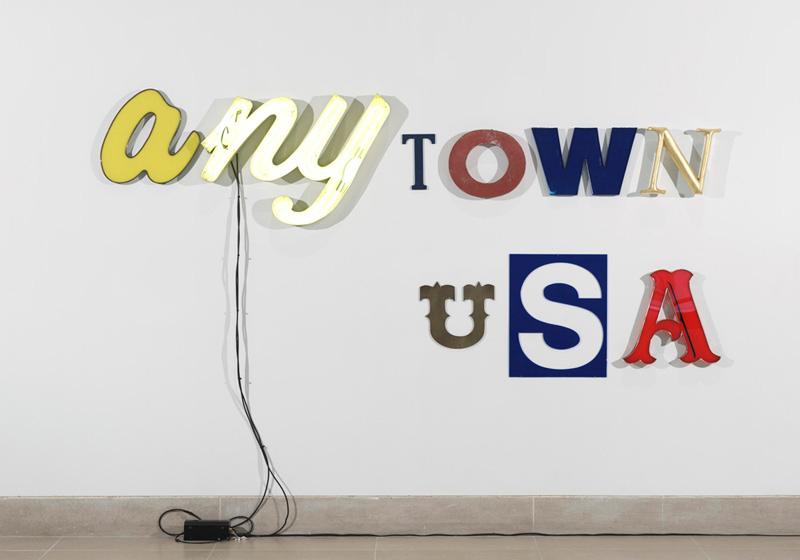
Anytown USA, Jack Pierson, 2000, Dallas Museum of Art, gift of the Junior Associates, 2004.10.a-i, © Jack Pierson
I repeated this same exercise with our docents this week, and their responses were equally as clever and creative. Below are descriptions for some of the businesses that the DMA docents think populate Anytown USA.
A is for Nan’s Diner, which has been around since the 1950s. The booths and stools are covered in yellow vinyl, and the diner is known for their breakfast menu. The A may also be from a sign for Carvel’s Ice Cream Shop, whose interior is decorated in primary colors. The whole store smells like hot fudge and cotton candy.
NY is for New York Bagels, a shop that’s open all night and is a favorite late night hangout. NY may also represent the New York Pantyhose Company, because the NY in this work of art comes in a pair–just like pantyhose!
T is for the Small Town News, a local newspaper that reports on weddings, births, and everything that’s happening at the schools. It might also stand for the Texaco gas station, which is still a full-service station.
O is from the sign of the John Silk Feed Store, which caters to farmers and ranchers. The employees are “good ol’ boys” and the store smells like hay, fertilizer, and cedar shavings. The O might also be from the sign of the Apothecary Shoppe, which had served the town for 60 years until it was forced to close because of a big chain store.
W may be from the sign of the family-owned Main Street Hardware Store. The store is cluttered, but they carry specialized products that you can’t find at other stores. The W might also belong to the Washateria, which is filled with the whir of washers and dryers.
U is for the Final Rest Undertakers, a quiet space decorated with muted colors. Past customers might say, “He looks so natural, but it costs so much.” On the other end of the spectrum, U might also be from the sign of a saloon/boarding house. A loud and crude place, there’s a player piano in the corner and women wander the lobby wearing only their petticoats.
S is for the General Store, whose owners know everyone in town. The stores sells everything you could ever need, and there’s also a large pickle barrel in the corner. The S could also be part of the sign for a soda fountain, which is the favorite hangout of all of the teenagers in Anytown USA.
A is part of the sign for the local baseball stadium, which houses a minor league team. It gives the town a sense of sophistication and makes it feel like maybe it’s a larger town than it actually is. The A could also be from the local Anheuser-Busch distributor, the town’s largest employer.
Without a doubt, the answers for that final A were unanimous in all four groups of docents who participated in this exercise. What is it about that font that screams baseball and/or beer?
Many of the docents commented on the sense of nostalgia that their responses held. I’m looking forward to trying this activity with students to find out if Anytown becomes more modern when it’s examined from their point-of-view.
Shannon Karol
Manager of Docent Programs and Gallery Teaching
Back Where It Started: Dallas Video Festival
Published September 19, 2012 Dallas , DFW , Guest Blog Post , Special Events 2 CommentsTags: Dallas Museum of Art, Dallas Video Festival, video art
Coming up in just ten short days, the Dallas Video Festival will launch its 25th Anniversary Festival here at the DMA. The festival will include screenings of feature-length works as well as shorts, animation, and other new media, “The Texas Show,” workshops, and more!
Recently, I spoke with Bart Weiss, DVF Artistic Director and all around “ video guy,” about the history of the festival.
So, the Video Festival is celebrating its 25th anniversary this year, back at its original home venue, the DMA. How did the Video Festival start and how did it happen to start at the DMA?
A dear and longtime friend of mine, John Held, Jr., was working on a program that was going to take place at the DMA called Video as a Creative Medium. It was a two-evening program; the first evening featured local video artists and the second evening featured video art from around the world, including works from Michael Smith and other up-and-coming video artists. It was a very successful program. Afterwards, I was chatting with John and Melissa Berry, the program manager at the DMA at the time, and just blurted out, “We should do this again next year, and for four days!” Thus the idea of the Video Festival was born.
I should also mention that on the first evening of the Video as a Creative Medium program, I met a lovely woman named Susan Teegarden, who is now my wife!
The Video Festival ran the first few years basically out of the DMA’s programming office and was not its own organization. Two of the founding board members of the official new organization, The Video Association of Dallas, were those very helpful and supportive DMA staffers–Melissa Berry and Sue Graze (the DMA’s contemporary art curator at the time).
What are a couple of your fondest memories of video festivals over the years?
Of course, I have many, many fond memories of past festivals, but one that really sticks out to me was one I could have never planned for. I cannot recall the exact year, but we had John Wylie Price participating in the festival. We were doing a program that included showing clips of the television show Amos ’n’ Andy. John was part of a conversation that debated whether this show was beneficial or damaging to the African American community since it often played upon stereotypes in the story lines.
We also had Steve Allen in town and he was going to be leading the program that was to follow Price’s. Allen attended Price’s program and instead of doing the schedule program, he ended up continuing the conversation with Price about how many communities–Jewish, African American, and others–often use humor to deal with the pain they experience as part of their history.
An absolutely incredible dialogue erupted and this moment is one that I think of often.
What can we expect at this year’s festival?
There are so many great things planned for this year’s festival–to pick out just a couple would be like looking down at your hands and deciding which finger on your hand was your favorite!
In general though, this year’s festival will feature many incredible Dallas filmmakers, who this year have made some of the greatest work of their lives. Some of these major local players whose work will be featured include (but are not limited to) Julia Dyer, Alan Govenar, Mark Birnbaum, and of course Allen and Cynthia Salzman Mondell, for whom we will hold a great tribute. All of this programming coming together so wonderfully is a statement to how important video art is, and doing the festival at the Museum makes it all the more powerful.
We hope to see you at the festival, September 27-30. For more details and to buy tickets and passes, visit the Dallas Video Festival’s website.
If you need further convincing to come check out the festival, here are a few pictures from Video Fests over the years.
[slideshow]
Denise Helbing is the Manager of Partner Programs at the Dallas Museum of Art.
Visit the Museum Without Leaving Your Classroom!
Published September 18, 2012 Art & Teaching , works of art ClosedTags: elementary outreach, Go van Gogh

Self-portrait collages created by 2nd grade students at Green Elementary during a Searching for Faces Go van Gogh program
Calling all teachers! Do your students like experimenting with art materials and exploring artworks from other times and places? As you begin to plan your school year, we hope you’ll consider inviting the Dallas Museum of Art to your classroom for a Go van Gogh outreach program. Here are some reasons we think Go van Gogh is a great way to spend a morning:
You can…
- Visit the Museum without leaving your classroom! Go van Gogh brings images of artworks from the Museum for interactive conversations.
- Make an artwork to take home. Go van Gogh brings all the supplies your class will need to make a take-home art project.
- Connect to your curriculum. Go van Gogh programs are geared for specific grade levels, and often dove-tail with subjects students are already learning.
- Travel around the world. Go van Gogh programs feature art from Africa, Mexico, Japan, and other far-off places.
- Get a free pass. Each student who participates in the Go van Gogh program receives a free family pass to visit the Museum.
Some quick facts about Go van Gogh:
- Programs are offered to 1st-6th grade classrooms at schools within Dallas city limits.
- Go van Gogh is free-of-charge!
- Scheduling is first-come, first-served. There is no limit to the number of programs you can schedule.
Visit our website to learn more about Go van Gogh program offerings and to schedule a program for your classroom.
We hope to visit your classrooms this school year!
Amy Copeland
Coordinator of Go van Gogh Outreach
